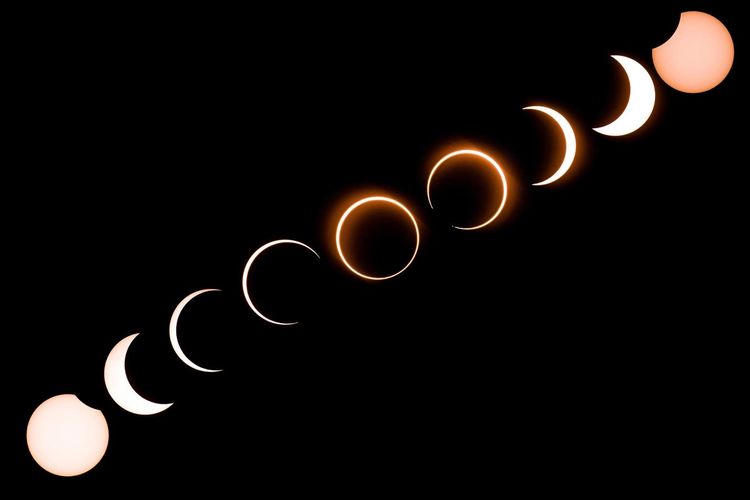Today's Eclipse Of The Full Moon Sets Up A 'Ring Of Fire' — What ...

This composite image shows the moon as it moves in front of the sun in a rare "ring of fire" solar ... [+] eclipse as seen from Tanjung Piai in Malaysia on December 26, 2019. (Photo by Sadiq ASYRAF / AFP)
AFP via Getty ImagesA new “eclipse season” is upon us—the first since April 8’s total solar eclipse across the U.S. Later today, a partial lunar eclipse—viewable from across the continental U.S. as well as the entire night side of the globe—will see the full “Harvest Moon” slip through Earth's shadow in space, turning its surface dark and appearing like it has a bite taken from it.
It’s a safe, easy to see and convenient celestial event, occurring shortly after moonrise where you. You can get the precise times of the “greatest eclipse”—where the effect will be most obvious and oddest-looking—by checking out this article.
However, for eclipse-hunters, it’s merely a warm-up because whenever there is an eclipse, another will follow. Just like clockwork, today’s “Harvest Supermoon Lunar Eclipse” kicks off two—and almost three—eclipses in succession:
September 17/18, 2024: penumbral lunar eclipse—“Harvest Supermoon Eclipse.” October 2, 2024: annular solar eclipse—“Ring of Fire.” October 17, 2024: an almost lunar eclipse—“Hunter’s Supermoon Eclipse.”Together, they make an “eclipse season.” Here's why:
‘Eclipse Seasons’ ExplainedA lunar eclipse occurs when Earth gets precisely between the sun and a full moon. A solar eclipse happens when a new moon gets precisely between the Earth and the sun. One is always preceded or followed by the other, creating a short season of eclipses. Just occasionally, they’re joined by a third eclipse, either a solar or lunar. That so very nearly happens in this eclipse season, when on October 17, 2024, the full “Hunter’s Moon” will almost—but not quite—enter Earth’s shadow in space.
An eclipse season is a period of between 31 and 37 days that occurs every 173 days. That means there must always be two eclipse seasons in the same calendar year.
Understanding why lunar and solar eclipses happen together is to comprehend how and why any kind of eclipse happens at all—and why they don’t happen every month.
Why Eclipses HappenEclipses come in seasons because that’s when the alignments are sufficient for either the moon to cross the sun’s disk or for it to drift into Earth’s shadow. The moon’s orbit of Earth is tilted by five degrees, so twice each month, it crosses the plane of Earth’s orbit of the sun—the apparent path of the sun through our sky. That path is called, tellingly, the ecliptic.
The two locations where the moon crosses the ecliptic are called nodes. It’s only when the moon being at one of those nodes coincides with it also being either new or full that an eclipse results. Two weeks on from a new moon, a full moon follows (or vice versa), so the other node is hit and another eclipse happens. Sometimes, it happens for a third time two weeks after that, too—something that almost happens this season.
October’s ‘Ring of Fire’ EclipseTwo weeks after tonight’s partial lunar eclipse, an annular solar eclipse will occur. It’s better known as a “ring of fire” eclipse because, at the event’s peak, the moon will cross the sun’s disk to cover its center, causing a ring of light around the new moon. It's less impactful than a total solar eclipse because the moon is a little farther away than on average, so it cannot cover 100% of the sun. The entire event also has to be viewed through solar eclipse safety glasses.
All solar eclipses are visible from a narrow path across Earth’s surface, beginning at sunrise at one location in the west and ending at another at sunset in the east. On October 2, from a narrow path through the Pacific Ocean to the Atlantic Ocean, via Easter Island, southern Chile and southern Argentina, the “ring of fire” will be visible for over six minutes. Expect stunning images from among the moai monoliths of Easter Island, and from the fjords and mountains of Patagonia.
A map of the annular solar eclipse on October 2, 2024, from the "Atlas of Solar Eclipses - 2020 to ... [+] 2045 by Michael Zeiler.
Michael Zeiler/GreatAmericanEclipse.com The Next ‘Eclipse Season’After this current eclipse season is over, there will be roughly six-month wait until the next one. That one will include a total lunar eclipse on March 14, 2025, and a partial solar eclipse on March 29, 2025. Both will be visible from the U.S., although only the extreme northeastern U.S. states will get a view of a sun rising in the east while eclipsed. It will occur precisely one lunar year after the total solar eclipse on April 8, 2024.
Now, there’s an eclipse season to get excited about.
Wishing you clear skies and wide eyes.















































